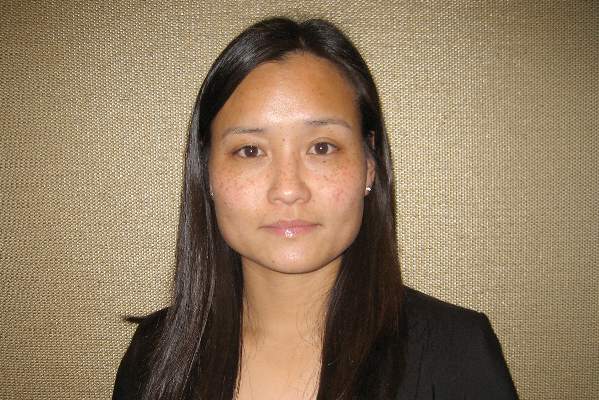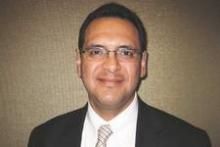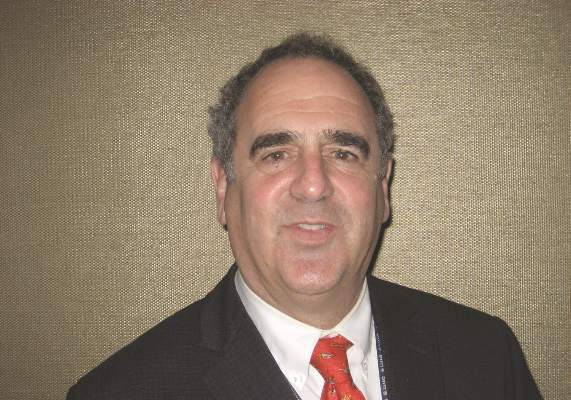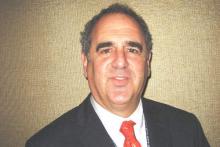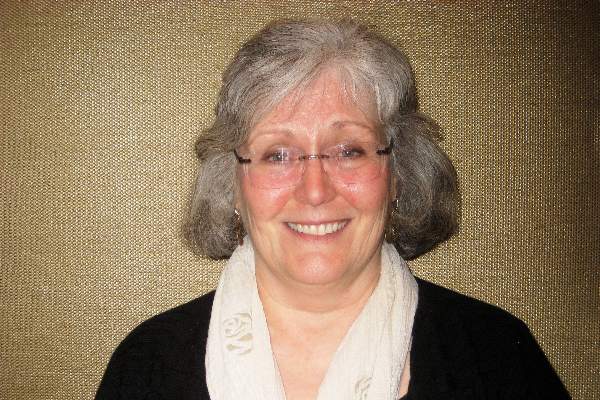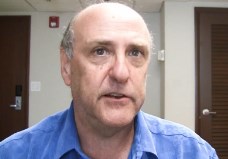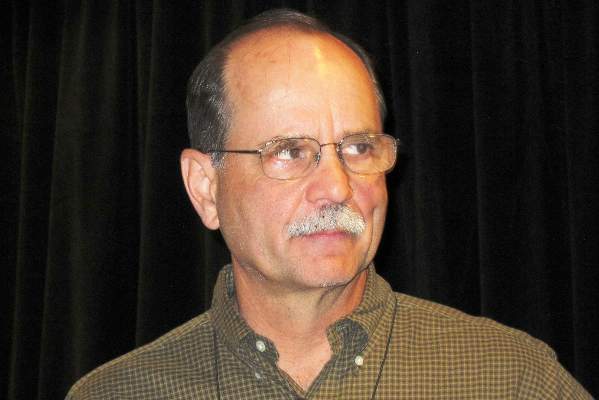User login
For MD-IQ on Family Practice News, but a regular topic for Rheumatology News
OARSI: Hydroxychloroquine disappoints in hand osteoarthritis
SEATTLE – Hydroxychloroquine is not efficacious for treating primary hand osteoarthritis, according to results from the first randomized trial to test the disease-modifying antirheumatic drug in this patient population.
Findings reported at the World Congress on Osteoarthritis showed that after 24 weeks of treatment, scores for pain and hand function budged little from baseline whether patients took hydroxychloroquine (Plaquenil) or a placebo. And although the drug was generally well tolerated, patients in that group more commonly had allergic reactions and developed rashes.
“The results of our study do not support the prescription of hydroxychloroquine in patients with hand osteoarthritis,” concluded lead investigator WeiChing Lee, Pharm.D., hospital pharmacist at the Maasstad Hospital Rotterdam in the Netherlands.
During a question and answer period, however, session attendees pointed out some study limitations that may still leave the door open for hydroxychloroquine in this setting.
“Thank you for doing this trial. I’ve always wanted to see a randomized, controlled trial looking at this. I’m a little depressed that it’s negative,” commented session attendee Dr. Grace Lo of the Baylor College of Medicine in Houston. An older case series did suggest a benefit of hydroxychloroquine in patients with more severe disease, “so I was wondering why you specifically excluded those people from this study.”
“We believed that patients with very severe disease are not likely to benefit from hydroxychloroquine because it is in the end stage,” Dr. Lee replied.
Dr. Lo further wondered if outcomes had been assessed separately among patients with different anatomic types of hand osteoarthritis, such as carpometacarpal osteoarthritis versus osteoarthritis of the proximal and distal interphalangeal joints. The investigators have not performed those analyses, according to Dr. Lee. “You just need to see if there is a difference,” Dr. Lo recommended.
Another attendee noted that pain scores at baseline suggested some patients had little to no pain. “Did you do a subgroup analysis looking at higher pain scores at baseline versus lower pain scores?” he asked.
“Yes, we did a subanalysis of patients with a pain score of 60 mm or more versus less [on a 100-mm scale], and we saw it improved with more severe pain symptoms; there was a decrease of 15 mm in the pain scores in both the placebo and hydroxychloroquine groups,” Dr. Lee replied, and still no difference between groups.
“Were you surprised there was no placebo response?” that attendee further asked.
“Yes, we were. That was the reason why we did the subanalysis,” Dr. Lee said; results showed a placebo effect in the group with more severe pain but not in the group with less severe pain.
A third attendee asked, “Do you have any data on how much inflammation these patients actually had at baseline? Could the lack of effect be due to low inflammation at baseline?”
The investigators have not looked at inflammatory markers, Dr. Lee replied.
In an interview, Dr. Xavier Chevalier, session comoderator and head of the department of rheumatology at the Henri Mondor Hospital, University Paris XII, in Créteil, France, agreed with the attendees’ points. “Unfortunately, this is a negative trial, but I’m afraid that the level of pain was not really well defined at the beginning of the study,” he said. “And it’s a little bit of a shame that they didn’t include patients with a very high level of pain.”
Introducing the study, Dr. Lee noted, “The cause and pathophysiology of hand osteoarthritis have not been clarified yet, but it is clear that inflammation plays an important tole. So it is believed that anti-inflammatory drugs might be effective in treating hand osteoarthritis.”
“Hydroxychloroquine is an anti-inflammatory drug that has been used successfully in other rheumatic diseases. It is prescribed commonly in hand osteoarthritis, but this indication is off label and not well investigated,” she said.
The investigators recruited to the trial 202 patients who met American College of Rheumatology criteria for primary hand osteoarthritis from outpatient rheumatology clinics in the Netherlands.
The patients had had pain from their arthritis for at least 1 year and had nodules or Kellgren-Lawrence grade 1, 2, or 3 changes in at least two symptomatic joints; those with grade 4 changes were excluded. They were randomized evenly to treatment with hydroxychloroquine (400 mg daily) or placebo.
Pain at baseline averaged about 44 mm on the 100-mm Visual Analog Scale (VAS) pain scale in each group, according to data reported at the meeting sponsored by the Osteoarthritis Research Society International.
Intention-to-treat analyses showed that at 24 weeks, the VAS score had increased by 0.10 mm in the placebo group and decreased by 1.3 mm in the hydroxychloroquine group, but the difference was not significant, reported Dr. Lee, who disclosed that she had no relevant conflicts of interest.
The groups were likewise statistically indistinguishable with respect to the change from baseline in the Australian/Canadian Osteoarthritis Hand Index (AUSCAN) scores and in total scores on the short form of the Arthritis Impact Measurement Scales 2 (AIMS2-SF).
About a fifth of patients in each group experienced adverse events. The hydroxychloroquine group had more allergic reactions (three vs. none) and cases of rash/pruritus (eight vs. three).
Dr. Lee disclosed that she had no relevant conflicts of interest.
SEATTLE – Hydroxychloroquine is not efficacious for treating primary hand osteoarthritis, according to results from the first randomized trial to test the disease-modifying antirheumatic drug in this patient population.
Findings reported at the World Congress on Osteoarthritis showed that after 24 weeks of treatment, scores for pain and hand function budged little from baseline whether patients took hydroxychloroquine (Plaquenil) or a placebo. And although the drug was generally well tolerated, patients in that group more commonly had allergic reactions and developed rashes.
“The results of our study do not support the prescription of hydroxychloroquine in patients with hand osteoarthritis,” concluded lead investigator WeiChing Lee, Pharm.D., hospital pharmacist at the Maasstad Hospital Rotterdam in the Netherlands.
During a question and answer period, however, session attendees pointed out some study limitations that may still leave the door open for hydroxychloroquine in this setting.
“Thank you for doing this trial. I’ve always wanted to see a randomized, controlled trial looking at this. I’m a little depressed that it’s negative,” commented session attendee Dr. Grace Lo of the Baylor College of Medicine in Houston. An older case series did suggest a benefit of hydroxychloroquine in patients with more severe disease, “so I was wondering why you specifically excluded those people from this study.”
“We believed that patients with very severe disease are not likely to benefit from hydroxychloroquine because it is in the end stage,” Dr. Lee replied.
Dr. Lo further wondered if outcomes had been assessed separately among patients with different anatomic types of hand osteoarthritis, such as carpometacarpal osteoarthritis versus osteoarthritis of the proximal and distal interphalangeal joints. The investigators have not performed those analyses, according to Dr. Lee. “You just need to see if there is a difference,” Dr. Lo recommended.
Another attendee noted that pain scores at baseline suggested some patients had little to no pain. “Did you do a subgroup analysis looking at higher pain scores at baseline versus lower pain scores?” he asked.
“Yes, we did a subanalysis of patients with a pain score of 60 mm or more versus less [on a 100-mm scale], and we saw it improved with more severe pain symptoms; there was a decrease of 15 mm in the pain scores in both the placebo and hydroxychloroquine groups,” Dr. Lee replied, and still no difference between groups.
“Were you surprised there was no placebo response?” that attendee further asked.
“Yes, we were. That was the reason why we did the subanalysis,” Dr. Lee said; results showed a placebo effect in the group with more severe pain but not in the group with less severe pain.
A third attendee asked, “Do you have any data on how much inflammation these patients actually had at baseline? Could the lack of effect be due to low inflammation at baseline?”
The investigators have not looked at inflammatory markers, Dr. Lee replied.
In an interview, Dr. Xavier Chevalier, session comoderator and head of the department of rheumatology at the Henri Mondor Hospital, University Paris XII, in Créteil, France, agreed with the attendees’ points. “Unfortunately, this is a negative trial, but I’m afraid that the level of pain was not really well defined at the beginning of the study,” he said. “And it’s a little bit of a shame that they didn’t include patients with a very high level of pain.”
Introducing the study, Dr. Lee noted, “The cause and pathophysiology of hand osteoarthritis have not been clarified yet, but it is clear that inflammation plays an important tole. So it is believed that anti-inflammatory drugs might be effective in treating hand osteoarthritis.”
“Hydroxychloroquine is an anti-inflammatory drug that has been used successfully in other rheumatic diseases. It is prescribed commonly in hand osteoarthritis, but this indication is off label and not well investigated,” she said.
The investigators recruited to the trial 202 patients who met American College of Rheumatology criteria for primary hand osteoarthritis from outpatient rheumatology clinics in the Netherlands.
The patients had had pain from their arthritis for at least 1 year and had nodules or Kellgren-Lawrence grade 1, 2, or 3 changes in at least two symptomatic joints; those with grade 4 changes were excluded. They were randomized evenly to treatment with hydroxychloroquine (400 mg daily) or placebo.
Pain at baseline averaged about 44 mm on the 100-mm Visual Analog Scale (VAS) pain scale in each group, according to data reported at the meeting sponsored by the Osteoarthritis Research Society International.
Intention-to-treat analyses showed that at 24 weeks, the VAS score had increased by 0.10 mm in the placebo group and decreased by 1.3 mm in the hydroxychloroquine group, but the difference was not significant, reported Dr. Lee, who disclosed that she had no relevant conflicts of interest.
The groups were likewise statistically indistinguishable with respect to the change from baseline in the Australian/Canadian Osteoarthritis Hand Index (AUSCAN) scores and in total scores on the short form of the Arthritis Impact Measurement Scales 2 (AIMS2-SF).
About a fifth of patients in each group experienced adverse events. The hydroxychloroquine group had more allergic reactions (three vs. none) and cases of rash/pruritus (eight vs. three).
Dr. Lee disclosed that she had no relevant conflicts of interest.
SEATTLE – Hydroxychloroquine is not efficacious for treating primary hand osteoarthritis, according to results from the first randomized trial to test the disease-modifying antirheumatic drug in this patient population.
Findings reported at the World Congress on Osteoarthritis showed that after 24 weeks of treatment, scores for pain and hand function budged little from baseline whether patients took hydroxychloroquine (Plaquenil) or a placebo. And although the drug was generally well tolerated, patients in that group more commonly had allergic reactions and developed rashes.
“The results of our study do not support the prescription of hydroxychloroquine in patients with hand osteoarthritis,” concluded lead investigator WeiChing Lee, Pharm.D., hospital pharmacist at the Maasstad Hospital Rotterdam in the Netherlands.
During a question and answer period, however, session attendees pointed out some study limitations that may still leave the door open for hydroxychloroquine in this setting.
“Thank you for doing this trial. I’ve always wanted to see a randomized, controlled trial looking at this. I’m a little depressed that it’s negative,” commented session attendee Dr. Grace Lo of the Baylor College of Medicine in Houston. An older case series did suggest a benefit of hydroxychloroquine in patients with more severe disease, “so I was wondering why you specifically excluded those people from this study.”
“We believed that patients with very severe disease are not likely to benefit from hydroxychloroquine because it is in the end stage,” Dr. Lee replied.
Dr. Lo further wondered if outcomes had been assessed separately among patients with different anatomic types of hand osteoarthritis, such as carpometacarpal osteoarthritis versus osteoarthritis of the proximal and distal interphalangeal joints. The investigators have not performed those analyses, according to Dr. Lee. “You just need to see if there is a difference,” Dr. Lo recommended.
Another attendee noted that pain scores at baseline suggested some patients had little to no pain. “Did you do a subgroup analysis looking at higher pain scores at baseline versus lower pain scores?” he asked.
“Yes, we did a subanalysis of patients with a pain score of 60 mm or more versus less [on a 100-mm scale], and we saw it improved with more severe pain symptoms; there was a decrease of 15 mm in the pain scores in both the placebo and hydroxychloroquine groups,” Dr. Lee replied, and still no difference between groups.
“Were you surprised there was no placebo response?” that attendee further asked.
“Yes, we were. That was the reason why we did the subanalysis,” Dr. Lee said; results showed a placebo effect in the group with more severe pain but not in the group with less severe pain.
A third attendee asked, “Do you have any data on how much inflammation these patients actually had at baseline? Could the lack of effect be due to low inflammation at baseline?”
The investigators have not looked at inflammatory markers, Dr. Lee replied.
In an interview, Dr. Xavier Chevalier, session comoderator and head of the department of rheumatology at the Henri Mondor Hospital, University Paris XII, in Créteil, France, agreed with the attendees’ points. “Unfortunately, this is a negative trial, but I’m afraid that the level of pain was not really well defined at the beginning of the study,” he said. “And it’s a little bit of a shame that they didn’t include patients with a very high level of pain.”
Introducing the study, Dr. Lee noted, “The cause and pathophysiology of hand osteoarthritis have not been clarified yet, but it is clear that inflammation plays an important tole. So it is believed that anti-inflammatory drugs might be effective in treating hand osteoarthritis.”
“Hydroxychloroquine is an anti-inflammatory drug that has been used successfully in other rheumatic diseases. It is prescribed commonly in hand osteoarthritis, but this indication is off label and not well investigated,” she said.
The investigators recruited to the trial 202 patients who met American College of Rheumatology criteria for primary hand osteoarthritis from outpatient rheumatology clinics in the Netherlands.
The patients had had pain from their arthritis for at least 1 year and had nodules or Kellgren-Lawrence grade 1, 2, or 3 changes in at least two symptomatic joints; those with grade 4 changes were excluded. They were randomized evenly to treatment with hydroxychloroquine (400 mg daily) or placebo.
Pain at baseline averaged about 44 mm on the 100-mm Visual Analog Scale (VAS) pain scale in each group, according to data reported at the meeting sponsored by the Osteoarthritis Research Society International.
Intention-to-treat analyses showed that at 24 weeks, the VAS score had increased by 0.10 mm in the placebo group and decreased by 1.3 mm in the hydroxychloroquine group, but the difference was not significant, reported Dr. Lee, who disclosed that she had no relevant conflicts of interest.
The groups were likewise statistically indistinguishable with respect to the change from baseline in the Australian/Canadian Osteoarthritis Hand Index (AUSCAN) scores and in total scores on the short form of the Arthritis Impact Measurement Scales 2 (AIMS2-SF).
About a fifth of patients in each group experienced adverse events. The hydroxychloroquine group had more allergic reactions (three vs. none) and cases of rash/pruritus (eight vs. three).
Dr. Lee disclosed that she had no relevant conflicts of interest.
AT OARSI 2015
Key clinical point: Hydroxychloroquine was not efficacious for treating hand osteoarthritis.
Major finding: The change in VAS pain score did not differ significantly between the hydroxychloroquine and placebo groups.
Data source: A randomized phase III trial among 202 patients with mild to moderate hand osteoarthritis.
Disclosures: Dr. Lee disclosed that she had no relevant conflicts of interest.
OARSI: Pain of knee osteoarthritis is worse for smokers
SEATTLE – Smoking is related to prevalent and incident joint pain in patients who have knee osteoarthritis or are at high risk for it, but the mechanism of this association is unclear, in a study of 3,026 patients.
“Previous studies have shown that compared to nonsmokers, smokers have more musculoskeletal pain and report more severe pain,” Jingbo Niu, D.Sc. of the Clinical Epidemiology Research & Training Unit at Boston University reported at the World Congress on Osteoarthritis.
Possible mechanisms include down-regulation of the hypothalamic-pituitary-adrenal axis or triggering of nicotine-sensitive acetylcholine receptors in the dorsal root ganglion. “These factors may translate to a change in pain perception among smokers,” she said.
Dr. Niu and her colleagues analyzed data from the Multicenter Osteoarthritis Study (MOST), a prospective cohort study of risk factors for the development and progression of knee osteoarthritis and knee pain in patients initially aged 50-79 years. They performed cross-sectional analyses at baseline and at the 7-year follow-up visit, and longitudinal analyses for the interim period.
At baseline, 56% of the cohort were never-smokers, 38% were former smokers, and 6% were current smokers, reported Dr. Niu, who disclosed that she had no relevant conflicts of interest. Smoking intensity averaged 22 pack-years.
Study results showed that at baseline, current smokers had significantly more severe knee pain than did never-smokers, with an adjusted difference of 0.83 points on the Western Ontario and McMaster Universities Osteoarthritis Index (WOMAC) knee pain scale.
Also at baseline, former smokers were more likely than were never-smokers to have widespread joint pain, defined as pain in all five regions of a joint pain homunculus (adjusted odds ratio, 1.3). And there was a dose-response relationship, whereby the greater the number of pack-years at baseline, the higher the risk of developing widespread joint pain during follow-up (P = .02).
However, neither smoking status nor smoking intensity was significantly associated with pain sensitization, assessed from the pressure pain threshold at the right wrist, according to the data reported at the meeting, which was sponsored by the Osteoarthritis Research Society International.
“We found smoking was related to knee pain severity and widespread pain, but not with pain sensitization,” Dr. Niu concluded.
“The number of current smokers in our analysis was limited,” she said. In addition, “subjects with knee pain were more likely to be recruited into the MOST study because they have a high risk of developing knee osteoarthritis. This inclusion criterion may lead to selection bias when we study knee pain and other pain-related outcomes.”
One session attendee noted that the confounders in the analyses did not include socioeconomic factors and recommended they be added. “Of course, smoking status could be confounded by socioeconomic factors, and couldn’t it just be that smoking is a surrogate measure?” he asked.
“It’s a good suggestion,” Dr. Niu agreed, noting that the data set has some socioeconomic measures, such as education, that could be incorporated into analyses.
In an interview, Dr. Timothy McAlindon, one of the session’s comoderators and a professor of medicine at Tufts University, Boston, said, “I think this is a very nicely done study looking at the association of smoking with pain in osteoarthritis.
“What they found is there is clearly a significant association of smoking with pain and incident widespread pain. What was less clear was the mechanistic relationship. Maybe they didn’t test the right mechanistic measures,” he proposed.
“If there is a causal relationship, it could perhaps suggest intervention. But I think that is very conjectural based on what they have done so far,” Dr. McAlindon concluded.
SEATTLE – Smoking is related to prevalent and incident joint pain in patients who have knee osteoarthritis or are at high risk for it, but the mechanism of this association is unclear, in a study of 3,026 patients.
“Previous studies have shown that compared to nonsmokers, smokers have more musculoskeletal pain and report more severe pain,” Jingbo Niu, D.Sc. of the Clinical Epidemiology Research & Training Unit at Boston University reported at the World Congress on Osteoarthritis.
Possible mechanisms include down-regulation of the hypothalamic-pituitary-adrenal axis or triggering of nicotine-sensitive acetylcholine receptors in the dorsal root ganglion. “These factors may translate to a change in pain perception among smokers,” she said.
Dr. Niu and her colleagues analyzed data from the Multicenter Osteoarthritis Study (MOST), a prospective cohort study of risk factors for the development and progression of knee osteoarthritis and knee pain in patients initially aged 50-79 years. They performed cross-sectional analyses at baseline and at the 7-year follow-up visit, and longitudinal analyses for the interim period.
At baseline, 56% of the cohort were never-smokers, 38% were former smokers, and 6% were current smokers, reported Dr. Niu, who disclosed that she had no relevant conflicts of interest. Smoking intensity averaged 22 pack-years.
Study results showed that at baseline, current smokers had significantly more severe knee pain than did never-smokers, with an adjusted difference of 0.83 points on the Western Ontario and McMaster Universities Osteoarthritis Index (WOMAC) knee pain scale.
Also at baseline, former smokers were more likely than were never-smokers to have widespread joint pain, defined as pain in all five regions of a joint pain homunculus (adjusted odds ratio, 1.3). And there was a dose-response relationship, whereby the greater the number of pack-years at baseline, the higher the risk of developing widespread joint pain during follow-up (P = .02).
However, neither smoking status nor smoking intensity was significantly associated with pain sensitization, assessed from the pressure pain threshold at the right wrist, according to the data reported at the meeting, which was sponsored by the Osteoarthritis Research Society International.
“We found smoking was related to knee pain severity and widespread pain, but not with pain sensitization,” Dr. Niu concluded.
“The number of current smokers in our analysis was limited,” she said. In addition, “subjects with knee pain were more likely to be recruited into the MOST study because they have a high risk of developing knee osteoarthritis. This inclusion criterion may lead to selection bias when we study knee pain and other pain-related outcomes.”
One session attendee noted that the confounders in the analyses did not include socioeconomic factors and recommended they be added. “Of course, smoking status could be confounded by socioeconomic factors, and couldn’t it just be that smoking is a surrogate measure?” he asked.
“It’s a good suggestion,” Dr. Niu agreed, noting that the data set has some socioeconomic measures, such as education, that could be incorporated into analyses.
In an interview, Dr. Timothy McAlindon, one of the session’s comoderators and a professor of medicine at Tufts University, Boston, said, “I think this is a very nicely done study looking at the association of smoking with pain in osteoarthritis.
“What they found is there is clearly a significant association of smoking with pain and incident widespread pain. What was less clear was the mechanistic relationship. Maybe they didn’t test the right mechanistic measures,” he proposed.
“If there is a causal relationship, it could perhaps suggest intervention. But I think that is very conjectural based on what they have done so far,” Dr. McAlindon concluded.
SEATTLE – Smoking is related to prevalent and incident joint pain in patients who have knee osteoarthritis or are at high risk for it, but the mechanism of this association is unclear, in a study of 3,026 patients.
“Previous studies have shown that compared to nonsmokers, smokers have more musculoskeletal pain and report more severe pain,” Jingbo Niu, D.Sc. of the Clinical Epidemiology Research & Training Unit at Boston University reported at the World Congress on Osteoarthritis.
Possible mechanisms include down-regulation of the hypothalamic-pituitary-adrenal axis or triggering of nicotine-sensitive acetylcholine receptors in the dorsal root ganglion. “These factors may translate to a change in pain perception among smokers,” she said.
Dr. Niu and her colleagues analyzed data from the Multicenter Osteoarthritis Study (MOST), a prospective cohort study of risk factors for the development and progression of knee osteoarthritis and knee pain in patients initially aged 50-79 years. They performed cross-sectional analyses at baseline and at the 7-year follow-up visit, and longitudinal analyses for the interim period.
At baseline, 56% of the cohort were never-smokers, 38% were former smokers, and 6% were current smokers, reported Dr. Niu, who disclosed that she had no relevant conflicts of interest. Smoking intensity averaged 22 pack-years.
Study results showed that at baseline, current smokers had significantly more severe knee pain than did never-smokers, with an adjusted difference of 0.83 points on the Western Ontario and McMaster Universities Osteoarthritis Index (WOMAC) knee pain scale.
Also at baseline, former smokers were more likely than were never-smokers to have widespread joint pain, defined as pain in all five regions of a joint pain homunculus (adjusted odds ratio, 1.3). And there was a dose-response relationship, whereby the greater the number of pack-years at baseline, the higher the risk of developing widespread joint pain during follow-up (P = .02).
However, neither smoking status nor smoking intensity was significantly associated with pain sensitization, assessed from the pressure pain threshold at the right wrist, according to the data reported at the meeting, which was sponsored by the Osteoarthritis Research Society International.
“We found smoking was related to knee pain severity and widespread pain, but not with pain sensitization,” Dr. Niu concluded.
“The number of current smokers in our analysis was limited,” she said. In addition, “subjects with knee pain were more likely to be recruited into the MOST study because they have a high risk of developing knee osteoarthritis. This inclusion criterion may lead to selection bias when we study knee pain and other pain-related outcomes.”
One session attendee noted that the confounders in the analyses did not include socioeconomic factors and recommended they be added. “Of course, smoking status could be confounded by socioeconomic factors, and couldn’t it just be that smoking is a surrogate measure?” he asked.
“It’s a good suggestion,” Dr. Niu agreed, noting that the data set has some socioeconomic measures, such as education, that could be incorporated into analyses.
In an interview, Dr. Timothy McAlindon, one of the session’s comoderators and a professor of medicine at Tufts University, Boston, said, “I think this is a very nicely done study looking at the association of smoking with pain in osteoarthritis.
“What they found is there is clearly a significant association of smoking with pain and incident widespread pain. What was less clear was the mechanistic relationship. Maybe they didn’t test the right mechanistic measures,” he proposed.
“If there is a causal relationship, it could perhaps suggest intervention. But I think that is very conjectural based on what they have done so far,” Dr. McAlindon concluded.
AT OARSI 2015
Key clinical point: Smoking is associated with prevalent and incident joint pain among older adults with knee osteoarthritis.
Major finding: Scores on the WOMAC knee pain scale were 0.83 points higher for current smokers than for never-smokers.
Data source: Cross-sectional and longitudinal analyses of a cohort of 3,026 patients with or at high risk for knee osteoarthritis.
Disclosures: Dr. Niu disclosed that she had no relevant conflicts of interest.
OARSI: Predictors of crossover to surgery identified in patients with meniscal tears and OA
SEATTLE – Certain clinical factors help predict which patients with knee meniscal tears and osteoarthritis will abandon physical therapy (PT) for surgery, according to a study reported at the World Congress on Osteoarthritis.
Investigators led by Dr. Jeffrey N. Katz performed a secondary analysis of the randomized, controlled MeTeOR (Meniscal Tear in Osteoarthritis Research) trial, which compared PT with arthroscopic partial meniscectomy among 351 patients.
Results showed that patients assigned to PT had a 6%-8% higher risk of crossing over to surgery if they had greater pain, a shorter symptom duration, or weaker hamstrings. But four-fifths of patients obtained pain relief from surgery, regardless of whether they were initially assigned to it or crossed over to it.
“Patients with the most painful and acute presentations and those with hamstring weakness were most likely to cross over from PT to arthroscopic partial meniscectomy in this trial,” commented Dr. Katz, who is a professor of rheumatology at Harvard Medical School and codirector of the Brigham Spine Center at Brigham and Women’s Hospital, Boston. However, “the risk ratios were very modest, suggesting we have limited capacity to predict crossovers.”
“From a research standpoint, crossovers compromise trial interpretation, so targeting patients most likely to cross over with efforts to try to retain them in their original treatment arm would enhance the value of trials,” he added. “From a clinical standpoint, there appears to be no disadvantage in delaying surgery until a trial of physical therapy has been undertaken, and that conclusion underscores the advice from many of these trials suggesting that PT be offered as first-line therapy for patients with degenerative meniscal tears.”
In an interview, Dr. Rolando Espinosa Morales, session comoderator and chief of the rheumatology service at the National Institute of Rehabilitation, Mexico City, said, “The study shows us there are no perfect predictors [of crossover] in these patients,” and careful evaluation is needed to discern which patients really need surgery and which will fare well with PT alone.
“It’s a hot topic right now in the world,” he commented. “We really don’t want to use surgery in all patients; we need to use it in a [restricted] number of patients.”
During a question and answer period, session attendee Ewa M. Roos, Ph.D., University of Southern Denmark in Odense, said, “You showed a lot of patient-related factors that could potentially explain crossover, but what is the role of the surgeon? … Is there a fact that if you can, you will cross over?”
“I agree with what I think is your implicit suggestion that there probably is a large role for the surgeon. We looked at heterogeneity in crossovers among surgeons in the trial, and there is some variability. There are probably cultural differences as well,” Dr. Katz replied. “I think … the question is, how fully are patients consented to not receiving surgery?”
Participants in MeTeOR were aged 45 years or older and had a meniscal tear on magnetic resonance imaging with degenerative cartilage changes and at least one meniscal symptom. They were randomized evenly to a standardized PT regimen emphasizing strength and range of motion, or to arthroscopic partial meniscectomy accompanied by standardized PT.
Overall, 27% of patients in the PT arm crossed over to surgery within about 5 months, Dr. Katz reported at the meeting sponsored by the Osteoarthritis Research Society International.
Multivariate analyses showed that patients initially assigned to PT were more likely to cross over to surgery if they had greater pain, scoring 40 or higher on the 100-point Western Ontario and McMaster Universities Osteoarthritis Index (WOMAC) pain scale (relative risk, 1.08); had experienced symptoms for less than a year (1.07); or had hamstring strength of less than 30 pounds (1.06).
However, the rate of treatment success, defined as an improvement of at least 10 points on the 100-point Knee Injury and Osteoarthritis Outcome Score (KOOS) at 6 months, was similarly high for the patients who were randomized to and received surgery (80%) and the patients who were randomized to PT but crossed over to surgery (81%).
The trial had several limitations, according to Dr. Katz. “From the standpoint of external validity, trial samples are not necessarily generalizable as we know. And with respect to internal validity, our comparison of immediate and delayed arthroscopic partial meniscectomy was post randomization, and the groups are not necessarily balanced,” he said.
Dr. Katz disclosed no relevant conflicts of interest.
SEATTLE – Certain clinical factors help predict which patients with knee meniscal tears and osteoarthritis will abandon physical therapy (PT) for surgery, according to a study reported at the World Congress on Osteoarthritis.
Investigators led by Dr. Jeffrey N. Katz performed a secondary analysis of the randomized, controlled MeTeOR (Meniscal Tear in Osteoarthritis Research) trial, which compared PT with arthroscopic partial meniscectomy among 351 patients.
Results showed that patients assigned to PT had a 6%-8% higher risk of crossing over to surgery if they had greater pain, a shorter symptom duration, or weaker hamstrings. But four-fifths of patients obtained pain relief from surgery, regardless of whether they were initially assigned to it or crossed over to it.
“Patients with the most painful and acute presentations and those with hamstring weakness were most likely to cross over from PT to arthroscopic partial meniscectomy in this trial,” commented Dr. Katz, who is a professor of rheumatology at Harvard Medical School and codirector of the Brigham Spine Center at Brigham and Women’s Hospital, Boston. However, “the risk ratios were very modest, suggesting we have limited capacity to predict crossovers.”
“From a research standpoint, crossovers compromise trial interpretation, so targeting patients most likely to cross over with efforts to try to retain them in their original treatment arm would enhance the value of trials,” he added. “From a clinical standpoint, there appears to be no disadvantage in delaying surgery until a trial of physical therapy has been undertaken, and that conclusion underscores the advice from many of these trials suggesting that PT be offered as first-line therapy for patients with degenerative meniscal tears.”
In an interview, Dr. Rolando Espinosa Morales, session comoderator and chief of the rheumatology service at the National Institute of Rehabilitation, Mexico City, said, “The study shows us there are no perfect predictors [of crossover] in these patients,” and careful evaluation is needed to discern which patients really need surgery and which will fare well with PT alone.
“It’s a hot topic right now in the world,” he commented. “We really don’t want to use surgery in all patients; we need to use it in a [restricted] number of patients.”
During a question and answer period, session attendee Ewa M. Roos, Ph.D., University of Southern Denmark in Odense, said, “You showed a lot of patient-related factors that could potentially explain crossover, but what is the role of the surgeon? … Is there a fact that if you can, you will cross over?”
“I agree with what I think is your implicit suggestion that there probably is a large role for the surgeon. We looked at heterogeneity in crossovers among surgeons in the trial, and there is some variability. There are probably cultural differences as well,” Dr. Katz replied. “I think … the question is, how fully are patients consented to not receiving surgery?”
Participants in MeTeOR were aged 45 years or older and had a meniscal tear on magnetic resonance imaging with degenerative cartilage changes and at least one meniscal symptom. They were randomized evenly to a standardized PT regimen emphasizing strength and range of motion, or to arthroscopic partial meniscectomy accompanied by standardized PT.
Overall, 27% of patients in the PT arm crossed over to surgery within about 5 months, Dr. Katz reported at the meeting sponsored by the Osteoarthritis Research Society International.
Multivariate analyses showed that patients initially assigned to PT were more likely to cross over to surgery if they had greater pain, scoring 40 or higher on the 100-point Western Ontario and McMaster Universities Osteoarthritis Index (WOMAC) pain scale (relative risk, 1.08); had experienced symptoms for less than a year (1.07); or had hamstring strength of less than 30 pounds (1.06).
However, the rate of treatment success, defined as an improvement of at least 10 points on the 100-point Knee Injury and Osteoarthritis Outcome Score (KOOS) at 6 months, was similarly high for the patients who were randomized to and received surgery (80%) and the patients who were randomized to PT but crossed over to surgery (81%).
The trial had several limitations, according to Dr. Katz. “From the standpoint of external validity, trial samples are not necessarily generalizable as we know. And with respect to internal validity, our comparison of immediate and delayed arthroscopic partial meniscectomy was post randomization, and the groups are not necessarily balanced,” he said.
Dr. Katz disclosed no relevant conflicts of interest.
SEATTLE – Certain clinical factors help predict which patients with knee meniscal tears and osteoarthritis will abandon physical therapy (PT) for surgery, according to a study reported at the World Congress on Osteoarthritis.
Investigators led by Dr. Jeffrey N. Katz performed a secondary analysis of the randomized, controlled MeTeOR (Meniscal Tear in Osteoarthritis Research) trial, which compared PT with arthroscopic partial meniscectomy among 351 patients.
Results showed that patients assigned to PT had a 6%-8% higher risk of crossing over to surgery if they had greater pain, a shorter symptom duration, or weaker hamstrings. But four-fifths of patients obtained pain relief from surgery, regardless of whether they were initially assigned to it or crossed over to it.
“Patients with the most painful and acute presentations and those with hamstring weakness were most likely to cross over from PT to arthroscopic partial meniscectomy in this trial,” commented Dr. Katz, who is a professor of rheumatology at Harvard Medical School and codirector of the Brigham Spine Center at Brigham and Women’s Hospital, Boston. However, “the risk ratios were very modest, suggesting we have limited capacity to predict crossovers.”
“From a research standpoint, crossovers compromise trial interpretation, so targeting patients most likely to cross over with efforts to try to retain them in their original treatment arm would enhance the value of trials,” he added. “From a clinical standpoint, there appears to be no disadvantage in delaying surgery until a trial of physical therapy has been undertaken, and that conclusion underscores the advice from many of these trials suggesting that PT be offered as first-line therapy for patients with degenerative meniscal tears.”
In an interview, Dr. Rolando Espinosa Morales, session comoderator and chief of the rheumatology service at the National Institute of Rehabilitation, Mexico City, said, “The study shows us there are no perfect predictors [of crossover] in these patients,” and careful evaluation is needed to discern which patients really need surgery and which will fare well with PT alone.
“It’s a hot topic right now in the world,” he commented. “We really don’t want to use surgery in all patients; we need to use it in a [restricted] number of patients.”
During a question and answer period, session attendee Ewa M. Roos, Ph.D., University of Southern Denmark in Odense, said, “You showed a lot of patient-related factors that could potentially explain crossover, but what is the role of the surgeon? … Is there a fact that if you can, you will cross over?”
“I agree with what I think is your implicit suggestion that there probably is a large role for the surgeon. We looked at heterogeneity in crossovers among surgeons in the trial, and there is some variability. There are probably cultural differences as well,” Dr. Katz replied. “I think … the question is, how fully are patients consented to not receiving surgery?”
Participants in MeTeOR were aged 45 years or older and had a meniscal tear on magnetic resonance imaging with degenerative cartilage changes and at least one meniscal symptom. They were randomized evenly to a standardized PT regimen emphasizing strength and range of motion, or to arthroscopic partial meniscectomy accompanied by standardized PT.
Overall, 27% of patients in the PT arm crossed over to surgery within about 5 months, Dr. Katz reported at the meeting sponsored by the Osteoarthritis Research Society International.
Multivariate analyses showed that patients initially assigned to PT were more likely to cross over to surgery if they had greater pain, scoring 40 or higher on the 100-point Western Ontario and McMaster Universities Osteoarthritis Index (WOMAC) pain scale (relative risk, 1.08); had experienced symptoms for less than a year (1.07); or had hamstring strength of less than 30 pounds (1.06).
However, the rate of treatment success, defined as an improvement of at least 10 points on the 100-point Knee Injury and Osteoarthritis Outcome Score (KOOS) at 6 months, was similarly high for the patients who were randomized to and received surgery (80%) and the patients who were randomized to PT but crossed over to surgery (81%).
The trial had several limitations, according to Dr. Katz. “From the standpoint of external validity, trial samples are not necessarily generalizable as we know. And with respect to internal validity, our comparison of immediate and delayed arthroscopic partial meniscectomy was post randomization, and the groups are not necessarily balanced,” he said.
Dr. Katz disclosed no relevant conflicts of interest.
AT OARSI 2015
Key clinical point: Clinical factors can help identify patients with knee meniscal tears and osteoarthritis who will eventually opt for arthroscopic partial meniscectomy.
Major finding: The risk of crossing over from PT to surgery was 6%-8% higher for patients who had greater pain, shorter symptom duration, or hamstring weakness.
Data source: An analysis of 351 patients with knee meniscal tears and osteoarthritis in a randomized trial of surgery vs. PT.
Disclosures: Dr. Katz disclosed no relevant conflicts of interest.
OARSI: Bisphosphonate users less likely to undergo knee replacement
SEATTLE – Women with knee osteoarthritis who took bisphosphonates were 27% less likely to undergo joint replacement surgery than were women who didn’t take bisphosphonates in a U.K. cohort study of 3,928 propensity-matched users and nonusers, according to a report at the World Congress on Osteoarthritis.
“In older women with incident knee osteoarthritis, incident bisphosphonate use may be associated with lower risk of knee replacement than in nonusers,” said Dr. Tuhina Neogi of Boston University.
Dr. Neogi and her colleagues used data from The Health Improvement Network (THIN), a U.K. database of primary care patients, to identify women aged 50-89 years who received a diagnosis of knee osteoarthritis between 2003 and 2012. Patients were excluded if they were poor surgical candidates or were taking disease-modifying antirheumatic drugs, biologic agents, or other bone-active agents.
The researchers compared 1,964 women who subsequently started bisphosphonate therapy with 1,964 propensity score–matched women who did not. In 85% of the former, the bisphosphonate was alendronate, marketed as Fosamax in the United States.
During a mean follow-up of 3 years, the incidence rate of knee replacement was 21 cases per 1,000 patient-years among bisphosphonate users and 29 cases per 1,000 patient-years among nonusers, according to results reported at the meeting, which was sponsored by Osteoarthritis Research Society International.
In adjusted analyses, users had a significantly lower relative risk of undergoing this surgery (hazard ratio, 0.73), reported Dr. Neogi, who disclosed that she had no relevant conflicts of interest.
Sensitivity analyses showed an even stronger association in a separate cohort of patients matched by age, body mass index, and the duration of osteoarthritis (hazard ratio, 0.33) and a nonsignificant benefit when bisphosphonate users were instead compared against an active user group of women who initiated any other bone-modulating therapy.
“Now of course this is observational data from electronic medical records, so we cannot rule out the potential for residual bias,” she acknowledged. “Our sensitivity analyses were fairly consistent and provide some reassurance, but nonetheless, the magnitude of effect is still likely to be biased due to residual confounding.”
In an interview, Dr. Rik Lories, one of the session’s comoderators and a professor at the University of Leuven, Belgium, said that the study “is still far from practice changing. But the great thing about this research is that we are starting to split up what you would call the osteoarthritic diseases, taking osteoarthritis as the outcome [and showing] the underlying mechanisms of the different phenotypes being different.”
Dr. Neogi noted that subchrondral bone changes are prominent in knee osteoarthritis and that mechanical factors play a central role in the disease. At the same time, findings of trials of antiresorptive agents, including bisphosphonates, in knee osteoarthritis have been conflicting.
“There are a number of limitations to this study, including the fact that The Health Improvement Network does not have bone mineral density results. We tried to address this by accounting for a prior diagnosis of osteoporosis, fracture history, potential risk for fractures, body mass index, age, number of bone mineral density tests ordered, et cetera,” Dr. Neogi said. “Another limitation is that of the secular trends in use of bone-modulating agents over this time frame, and that precluded robust evaluation of the active user comparator analysis.
“Bone mineral density is still a major potential confounder here that can’t be adequately addressed,” she acknowledged.
SEATTLE – Women with knee osteoarthritis who took bisphosphonates were 27% less likely to undergo joint replacement surgery than were women who didn’t take bisphosphonates in a U.K. cohort study of 3,928 propensity-matched users and nonusers, according to a report at the World Congress on Osteoarthritis.
“In older women with incident knee osteoarthritis, incident bisphosphonate use may be associated with lower risk of knee replacement than in nonusers,” said Dr. Tuhina Neogi of Boston University.
Dr. Neogi and her colleagues used data from The Health Improvement Network (THIN), a U.K. database of primary care patients, to identify women aged 50-89 years who received a diagnosis of knee osteoarthritis between 2003 and 2012. Patients were excluded if they were poor surgical candidates or were taking disease-modifying antirheumatic drugs, biologic agents, or other bone-active agents.
The researchers compared 1,964 women who subsequently started bisphosphonate therapy with 1,964 propensity score–matched women who did not. In 85% of the former, the bisphosphonate was alendronate, marketed as Fosamax in the United States.
During a mean follow-up of 3 years, the incidence rate of knee replacement was 21 cases per 1,000 patient-years among bisphosphonate users and 29 cases per 1,000 patient-years among nonusers, according to results reported at the meeting, which was sponsored by Osteoarthritis Research Society International.
In adjusted analyses, users had a significantly lower relative risk of undergoing this surgery (hazard ratio, 0.73), reported Dr. Neogi, who disclosed that she had no relevant conflicts of interest.
Sensitivity analyses showed an even stronger association in a separate cohort of patients matched by age, body mass index, and the duration of osteoarthritis (hazard ratio, 0.33) and a nonsignificant benefit when bisphosphonate users were instead compared against an active user group of women who initiated any other bone-modulating therapy.
“Now of course this is observational data from electronic medical records, so we cannot rule out the potential for residual bias,” she acknowledged. “Our sensitivity analyses were fairly consistent and provide some reassurance, but nonetheless, the magnitude of effect is still likely to be biased due to residual confounding.”
In an interview, Dr. Rik Lories, one of the session’s comoderators and a professor at the University of Leuven, Belgium, said that the study “is still far from practice changing. But the great thing about this research is that we are starting to split up what you would call the osteoarthritic diseases, taking osteoarthritis as the outcome [and showing] the underlying mechanisms of the different phenotypes being different.”
Dr. Neogi noted that subchrondral bone changes are prominent in knee osteoarthritis and that mechanical factors play a central role in the disease. At the same time, findings of trials of antiresorptive agents, including bisphosphonates, in knee osteoarthritis have been conflicting.
“There are a number of limitations to this study, including the fact that The Health Improvement Network does not have bone mineral density results. We tried to address this by accounting for a prior diagnosis of osteoporosis, fracture history, potential risk for fractures, body mass index, age, number of bone mineral density tests ordered, et cetera,” Dr. Neogi said. “Another limitation is that of the secular trends in use of bone-modulating agents over this time frame, and that precluded robust evaluation of the active user comparator analysis.
“Bone mineral density is still a major potential confounder here that can’t be adequately addressed,” she acknowledged.
SEATTLE – Women with knee osteoarthritis who took bisphosphonates were 27% less likely to undergo joint replacement surgery than were women who didn’t take bisphosphonates in a U.K. cohort study of 3,928 propensity-matched users and nonusers, according to a report at the World Congress on Osteoarthritis.
“In older women with incident knee osteoarthritis, incident bisphosphonate use may be associated with lower risk of knee replacement than in nonusers,” said Dr. Tuhina Neogi of Boston University.
Dr. Neogi and her colleagues used data from The Health Improvement Network (THIN), a U.K. database of primary care patients, to identify women aged 50-89 years who received a diagnosis of knee osteoarthritis between 2003 and 2012. Patients were excluded if they were poor surgical candidates or were taking disease-modifying antirheumatic drugs, biologic agents, or other bone-active agents.
The researchers compared 1,964 women who subsequently started bisphosphonate therapy with 1,964 propensity score–matched women who did not. In 85% of the former, the bisphosphonate was alendronate, marketed as Fosamax in the United States.
During a mean follow-up of 3 years, the incidence rate of knee replacement was 21 cases per 1,000 patient-years among bisphosphonate users and 29 cases per 1,000 patient-years among nonusers, according to results reported at the meeting, which was sponsored by Osteoarthritis Research Society International.
In adjusted analyses, users had a significantly lower relative risk of undergoing this surgery (hazard ratio, 0.73), reported Dr. Neogi, who disclosed that she had no relevant conflicts of interest.
Sensitivity analyses showed an even stronger association in a separate cohort of patients matched by age, body mass index, and the duration of osteoarthritis (hazard ratio, 0.33) and a nonsignificant benefit when bisphosphonate users were instead compared against an active user group of women who initiated any other bone-modulating therapy.
“Now of course this is observational data from electronic medical records, so we cannot rule out the potential for residual bias,” she acknowledged. “Our sensitivity analyses were fairly consistent and provide some reassurance, but nonetheless, the magnitude of effect is still likely to be biased due to residual confounding.”
In an interview, Dr. Rik Lories, one of the session’s comoderators and a professor at the University of Leuven, Belgium, said that the study “is still far from practice changing. But the great thing about this research is that we are starting to split up what you would call the osteoarthritic diseases, taking osteoarthritis as the outcome [and showing] the underlying mechanisms of the different phenotypes being different.”
Dr. Neogi noted that subchrondral bone changes are prominent in knee osteoarthritis and that mechanical factors play a central role in the disease. At the same time, findings of trials of antiresorptive agents, including bisphosphonates, in knee osteoarthritis have been conflicting.
“There are a number of limitations to this study, including the fact that The Health Improvement Network does not have bone mineral density results. We tried to address this by accounting for a prior diagnosis of osteoporosis, fracture history, potential risk for fractures, body mass index, age, number of bone mineral density tests ordered, et cetera,” Dr. Neogi said. “Another limitation is that of the secular trends in use of bone-modulating agents over this time frame, and that precluded robust evaluation of the active user comparator analysis.
“Bone mineral density is still a major potential confounder here that can’t be adequately addressed,” she acknowledged.
AT OARSI 2015
Key clinical point: Bisphosphonate use by women with knee arthritis was associated with a reduced rate of knee surgery.
Major finding: Women who began using bisphosphonates had a 27% lower risk of total knee replacement surgery.
Data source: A cohort study of 3,928 women aged 50-89 who had knee osteoarthritis.
Disclosures: Dr. Neogi disclosed that she had no relevant conflicts of interest.
OARSI: Model helps predict readmission after joint replacement
SEATTLE – Adding clinical factors to a commonly used risk model improves by about 20% the prediction of which patients will be readmitted after undergoing total joint replacement surgery, new data show.
The new, combined model employs diagnostic codes and a variety of clinical factors, such as preoperative patient-reported measures – emotional status assessed with the mental component score of the 12-item Short Form Health Survey, moderate to severe pain in other weight-bearing joints (the contralateral joint, the hips or knees, and low back), and history of smoking – and the Charlson comorbidity index.
Investigators led by Dr. Patricia D. Franklin, a professor in the department of orthopedics and physical rehabilitation, University of Massachusetts, Worcester, set out to improve on the Centers for Medicare & Medicaid (CMS) risk prediction model for 30-day readmission. Rates of readmission using the model are publicly reported as an indicator of the quality of care at hospitals.
“Analyses are described as risk adjusted, implying that the remaining outcome variation is due to variation in quality of care,” she told attendees of the World Congress on Osteoarthritis. “The CMS risk adjustment model, while expertly developed, was limited to the billing and diagnosis data that were available to them and for patients over 65 years of age.”
The researchers tested the model using data from FORCE-TJR (Function and Outcomes Research for Comparative Effectiveness in Total Joint Replacement and Quality Improvement), the first national total joint replacement registry. Analyses were based on 2,560 patients aged 65 years or older who underwent total knee or hip replacement during 2011 and 2012.
Overall, 4.7% of the patients were readmitted within 30 days. About one-third of the readmissions were for implant-related issues, while the rest were due to complications of a major surgery in older patients with comorbidities, according to Dr. Franklin, who disclosed that she has received investigator-initiated research awards from Zimmer and Biomet.
In multivariate analysis, discrimination of patients having a readmission with the combined model was superior to that with the model based on diagnostic codes alone (c-statistic, 0.75 vs. 0.64), she reported at the meeting sponsored by the Osteoarthritis Research Society International.
“We believe that in the combined risk-adjustment model … the key predictors were indeed older age and gender and that list of ICD codes. However, the addition of medical and musculoskeletal comorbidities – in particular, moderate and severe pain in other weight-bearing joints – was important to the success,” Dr. Franklin commented, noting that the findings will be validated using 2013 registry data.
“We have been advising total joint replacement surgeons to collect these musculoskeletal factors in a systematic way so that they can be included in these future analyses. We believe it would be wise to integrate clinician-defined and -reported risk factors before public reporting,” she concluded.
Session attendee Dr. Jeffrey N. Katz, a professor at Harvard Medical School and codirector of the Brigham Spine Center at Brigham and Women’s Hospital, Boston, wondered whether pain in the other knee is a proxy for the severity and systemic nature of the osteoarthritis in these patients.
Identifying the real risk factors at play will be important, Dr. Katz said, adding, “I think we see this a lot in risk models. ... and addressing the proxy may not address the underlying issue.”
“I’m just very afraid of the law of unintended consequences” of risk models potentially being used to deny some patients surgery, commented session comoderator Dr. Nigel Arden, professor of rheumatology at the University of Oxford, England.
“A lot of the risk factors you identified were not obviously reversible,” Dr. Arden commented. “So are these people going to get prehab, or would you operate but do lots of extensive postoperative rehab? Or is this going to be a patient decision aid?”
The main aims of the research were to better ensure that the model was truly reflecting surgical care and to provide surgeons with information for planning and counseling patients, according to Dr. Franklin.
“I think patients should be informed what their risk is. … Average readmission rates or mortality rates don’t inform individuals,” she added. “So our goal actually is to begin to have some strategies to parse out subgroups of patients at greater or lesser risk for complications, and for benefits from the surgery.”
SEATTLE – Adding clinical factors to a commonly used risk model improves by about 20% the prediction of which patients will be readmitted after undergoing total joint replacement surgery, new data show.
The new, combined model employs diagnostic codes and a variety of clinical factors, such as preoperative patient-reported measures – emotional status assessed with the mental component score of the 12-item Short Form Health Survey, moderate to severe pain in other weight-bearing joints (the contralateral joint, the hips or knees, and low back), and history of smoking – and the Charlson comorbidity index.
Investigators led by Dr. Patricia D. Franklin, a professor in the department of orthopedics and physical rehabilitation, University of Massachusetts, Worcester, set out to improve on the Centers for Medicare & Medicaid (CMS) risk prediction model for 30-day readmission. Rates of readmission using the model are publicly reported as an indicator of the quality of care at hospitals.
“Analyses are described as risk adjusted, implying that the remaining outcome variation is due to variation in quality of care,” she told attendees of the World Congress on Osteoarthritis. “The CMS risk adjustment model, while expertly developed, was limited to the billing and diagnosis data that were available to them and for patients over 65 years of age.”
The researchers tested the model using data from FORCE-TJR (Function and Outcomes Research for Comparative Effectiveness in Total Joint Replacement and Quality Improvement), the first national total joint replacement registry. Analyses were based on 2,560 patients aged 65 years or older who underwent total knee or hip replacement during 2011 and 2012.
Overall, 4.7% of the patients were readmitted within 30 days. About one-third of the readmissions were for implant-related issues, while the rest were due to complications of a major surgery in older patients with comorbidities, according to Dr. Franklin, who disclosed that she has received investigator-initiated research awards from Zimmer and Biomet.
In multivariate analysis, discrimination of patients having a readmission with the combined model was superior to that with the model based on diagnostic codes alone (c-statistic, 0.75 vs. 0.64), she reported at the meeting sponsored by the Osteoarthritis Research Society International.
“We believe that in the combined risk-adjustment model … the key predictors were indeed older age and gender and that list of ICD codes. However, the addition of medical and musculoskeletal comorbidities – in particular, moderate and severe pain in other weight-bearing joints – was important to the success,” Dr. Franklin commented, noting that the findings will be validated using 2013 registry data.
“We have been advising total joint replacement surgeons to collect these musculoskeletal factors in a systematic way so that they can be included in these future analyses. We believe it would be wise to integrate clinician-defined and -reported risk factors before public reporting,” she concluded.
Session attendee Dr. Jeffrey N. Katz, a professor at Harvard Medical School and codirector of the Brigham Spine Center at Brigham and Women’s Hospital, Boston, wondered whether pain in the other knee is a proxy for the severity and systemic nature of the osteoarthritis in these patients.
Identifying the real risk factors at play will be important, Dr. Katz said, adding, “I think we see this a lot in risk models. ... and addressing the proxy may not address the underlying issue.”
“I’m just very afraid of the law of unintended consequences” of risk models potentially being used to deny some patients surgery, commented session comoderator Dr. Nigel Arden, professor of rheumatology at the University of Oxford, England.
“A lot of the risk factors you identified were not obviously reversible,” Dr. Arden commented. “So are these people going to get prehab, or would you operate but do lots of extensive postoperative rehab? Or is this going to be a patient decision aid?”
The main aims of the research were to better ensure that the model was truly reflecting surgical care and to provide surgeons with information for planning and counseling patients, according to Dr. Franklin.
“I think patients should be informed what their risk is. … Average readmission rates or mortality rates don’t inform individuals,” she added. “So our goal actually is to begin to have some strategies to parse out subgroups of patients at greater or lesser risk for complications, and for benefits from the surgery.”
SEATTLE – Adding clinical factors to a commonly used risk model improves by about 20% the prediction of which patients will be readmitted after undergoing total joint replacement surgery, new data show.
The new, combined model employs diagnostic codes and a variety of clinical factors, such as preoperative patient-reported measures – emotional status assessed with the mental component score of the 12-item Short Form Health Survey, moderate to severe pain in other weight-bearing joints (the contralateral joint, the hips or knees, and low back), and history of smoking – and the Charlson comorbidity index.
Investigators led by Dr. Patricia D. Franklin, a professor in the department of orthopedics and physical rehabilitation, University of Massachusetts, Worcester, set out to improve on the Centers for Medicare & Medicaid (CMS) risk prediction model for 30-day readmission. Rates of readmission using the model are publicly reported as an indicator of the quality of care at hospitals.
“Analyses are described as risk adjusted, implying that the remaining outcome variation is due to variation in quality of care,” she told attendees of the World Congress on Osteoarthritis. “The CMS risk adjustment model, while expertly developed, was limited to the billing and diagnosis data that were available to them and for patients over 65 years of age.”
The researchers tested the model using data from FORCE-TJR (Function and Outcomes Research for Comparative Effectiveness in Total Joint Replacement and Quality Improvement), the first national total joint replacement registry. Analyses were based on 2,560 patients aged 65 years or older who underwent total knee or hip replacement during 2011 and 2012.
Overall, 4.7% of the patients were readmitted within 30 days. About one-third of the readmissions were for implant-related issues, while the rest were due to complications of a major surgery in older patients with comorbidities, according to Dr. Franklin, who disclosed that she has received investigator-initiated research awards from Zimmer and Biomet.
In multivariate analysis, discrimination of patients having a readmission with the combined model was superior to that with the model based on diagnostic codes alone (c-statistic, 0.75 vs. 0.64), she reported at the meeting sponsored by the Osteoarthritis Research Society International.
“We believe that in the combined risk-adjustment model … the key predictors were indeed older age and gender and that list of ICD codes. However, the addition of medical and musculoskeletal comorbidities – in particular, moderate and severe pain in other weight-bearing joints – was important to the success,” Dr. Franklin commented, noting that the findings will be validated using 2013 registry data.
“We have been advising total joint replacement surgeons to collect these musculoskeletal factors in a systematic way so that they can be included in these future analyses. We believe it would be wise to integrate clinician-defined and -reported risk factors before public reporting,” she concluded.
Session attendee Dr. Jeffrey N. Katz, a professor at Harvard Medical School and codirector of the Brigham Spine Center at Brigham and Women’s Hospital, Boston, wondered whether pain in the other knee is a proxy for the severity and systemic nature of the osteoarthritis in these patients.
Identifying the real risk factors at play will be important, Dr. Katz said, adding, “I think we see this a lot in risk models. ... and addressing the proxy may not address the underlying issue.”
“I’m just very afraid of the law of unintended consequences” of risk models potentially being used to deny some patients surgery, commented session comoderator Dr. Nigel Arden, professor of rheumatology at the University of Oxford, England.
“A lot of the risk factors you identified were not obviously reversible,” Dr. Arden commented. “So are these people going to get prehab, or would you operate but do lots of extensive postoperative rehab? Or is this going to be a patient decision aid?”
The main aims of the research were to better ensure that the model was truly reflecting surgical care and to provide surgeons with information for planning and counseling patients, according to Dr. Franklin.
“I think patients should be informed what their risk is. … Average readmission rates or mortality rates don’t inform individuals,” she added. “So our goal actually is to begin to have some strategies to parse out subgroups of patients at greater or lesser risk for complications, and for benefits from the surgery.”
AT OARSI 2015
Key clinical point: Adding clinical factors to diagnostic codes improves prediction of 30-day readmission after total joint replacement surgery.
Major finding: The c-statistic increased from 0.64 without the clinical factors to 0.75 with the clinical factors.
Data source: A cohort study of 2,560 older adults undergoing total knee or hip replacement.
Disclosures: Dr. Franklin disclosed that she has received investigator-initiated research awards from Zimmer and Biomet.
Limited benefits for osteoarthritis patients from acetaminophen
Acetaminophen is ineffective for short-term treatment of low back pain and has limited benefit for patients with knee or hip osteoarthritis, according to a systematic review of randomized, controlled trials by Gustavo Machado and his associates.
In three trials, there was no significant difference between acetaminophen and a placebo on pain relief for people with low back pain. In 10 trials involving patients with hip or knee osteoarthritis, acetaminophen provided a statistically significant benefit over placebo, but the effect was small. There were similar rates of adverse side effects, medication adherence, and use of rescue medication in both groups.
The review also “found higher risk of abnormal results on liver function tests in patients taking [acetaminophen], though the clinical implications of this are uncertain,” the investigators said.
Find the full review in the BMJ (doi:10.1136/bmj.h1225).
Acetaminophen is ineffective for short-term treatment of low back pain and has limited benefit for patients with knee or hip osteoarthritis, according to a systematic review of randomized, controlled trials by Gustavo Machado and his associates.
In three trials, there was no significant difference between acetaminophen and a placebo on pain relief for people with low back pain. In 10 trials involving patients with hip or knee osteoarthritis, acetaminophen provided a statistically significant benefit over placebo, but the effect was small. There were similar rates of adverse side effects, medication adherence, and use of rescue medication in both groups.
The review also “found higher risk of abnormal results on liver function tests in patients taking [acetaminophen], though the clinical implications of this are uncertain,” the investigators said.
Find the full review in the BMJ (doi:10.1136/bmj.h1225).
Acetaminophen is ineffective for short-term treatment of low back pain and has limited benefit for patients with knee or hip osteoarthritis, according to a systematic review of randomized, controlled trials by Gustavo Machado and his associates.
In three trials, there was no significant difference between acetaminophen and a placebo on pain relief for people with low back pain. In 10 trials involving patients with hip or knee osteoarthritis, acetaminophen provided a statistically significant benefit over placebo, but the effect was small. There were similar rates of adverse side effects, medication adherence, and use of rescue medication in both groups.
The review also “found higher risk of abnormal results on liver function tests in patients taking [acetaminophen], though the clinical implications of this are uncertain,” the investigators said.
Find the full review in the BMJ (doi:10.1136/bmj.h1225).
Overall physical health strongly predicts arthritis pain
Physical health, previous joint pain, and the presence of diabetes can strongly predict whether a patient with arthritis will experience pain, say researchers presenting their findings at the annual meeting of the American Academy of Orthopaedic Surgeons in Las Vegas.
Man Hung, Ph.D., of the department of orthopaedic surgery operations at the University of Utah in Salt Lake City and her colleagues created several algorithms for predicting arthritis pain based on data from a sample of 5,721 U.S. adults with arthritis with an average age of 60 years.
They discovered that specific combinations of physical health, mental health, and general health status, as well as diabetes, previous joint pain, and a patient’s education level, predicted pain in people with arthritis.
Physical health status the greatest predictor of pain that limited work, whereas a body mass index greater than 30 kg/m2 was not linked to pain, the researchers found.
One of the algorithms that the researchers developed was able to predict pain at an accuracy rate of 98.6%, they said
The algorithms offer new insights of pain, allowing the development of cost-effective care management programs for those experiencing arthritis, they concluded.
Physical health, previous joint pain, and the presence of diabetes can strongly predict whether a patient with arthritis will experience pain, say researchers presenting their findings at the annual meeting of the American Academy of Orthopaedic Surgeons in Las Vegas.
Man Hung, Ph.D., of the department of orthopaedic surgery operations at the University of Utah in Salt Lake City and her colleagues created several algorithms for predicting arthritis pain based on data from a sample of 5,721 U.S. adults with arthritis with an average age of 60 years.
They discovered that specific combinations of physical health, mental health, and general health status, as well as diabetes, previous joint pain, and a patient’s education level, predicted pain in people with arthritis.
Physical health status the greatest predictor of pain that limited work, whereas a body mass index greater than 30 kg/m2 was not linked to pain, the researchers found.
One of the algorithms that the researchers developed was able to predict pain at an accuracy rate of 98.6%, they said
The algorithms offer new insights of pain, allowing the development of cost-effective care management programs for those experiencing arthritis, they concluded.
Physical health, previous joint pain, and the presence of diabetes can strongly predict whether a patient with arthritis will experience pain, say researchers presenting their findings at the annual meeting of the American Academy of Orthopaedic Surgeons in Las Vegas.
Man Hung, Ph.D., of the department of orthopaedic surgery operations at the University of Utah in Salt Lake City and her colleagues created several algorithms for predicting arthritis pain based on data from a sample of 5,721 U.S. adults with arthritis with an average age of 60 years.
They discovered that specific combinations of physical health, mental health, and general health status, as well as diabetes, previous joint pain, and a patient’s education level, predicted pain in people with arthritis.
Physical health status the greatest predictor of pain that limited work, whereas a body mass index greater than 30 kg/m2 was not linked to pain, the researchers found.
One of the algorithms that the researchers developed was able to predict pain at an accuracy rate of 98.6%, they said
The algorithms offer new insights of pain, allowing the development of cost-effective care management programs for those experiencing arthritis, they concluded.
Study: Osteoarthritis develops sooner than thought after ACL injury, repair
People who have had a knee reconstruction following trauma may be susceptible to osteoarthritis sooner than currently thought, according to new MRI findings at 1 year after anterior cruciate ligament reconstruction.
Almost a third of people studied had some evidence of early osteoarthritis (OA) at that early time point, challenging “existing dogma that degenerative joint disease does not become apparent for years post-ACLR,” reported Dr. Kay Crossley of the University of Queensland in Brisbane, Australia (Arthritis Rheumatol. 2015 Feb. 18 [doi:10.1002/art.39005]).
However, as they did not have access to preoperative images, they could not rule out that some OA features may have been preexisting and not related to knee trauma, they said.
“This is a sample that was taken after the injury and after the reconstruction, so they truly don’t know that what they’re finding is as a result of even the injury, surgery, or the meniscal damage or meniscal resection they had done at the time,” Dr. David J. Hunter, a leading OA expert from Sydney (Australia) University, said when asked to comment on the study’s findings.
“It may well be that these were people that had some underlying structural damage,” he added.
The researchers noted that radiographic knee OA was thought to be as high as 50%-90% a decade after anterior cruciate ligament reconstruction (ACLR). The issue is particularly important because ACL injuries typically occur in younger adults who are then prone to developing knee OA before they reach 40 years, they said.
“Early detection of knee OA after ACLR may permit early intervention such as load management, which is likely to be more effective prior to the development of advanced disease,” they wrote.
Their study included 111 patients aged 18-50 years who had undergone single-bundle hamstring-tendon autograft ACLR 1 year earlier.
MRI scans of their knees were compared with 20 uninjured asymptomatic matched controls. The researchers used the MRI Osteoarthritis Knee Score (MOAKS) to score specific OA features because the more recent Anterior Cruciate Ligament Osteoarthritis Score (ACLOAS) had not been published at the time of their study.
Results showed that 34 (31%) patients had MRI-defined knee OA following an ACLR a year earlier.
MRI-OA features were most frequently found in the patellofemoral compartment, particularly the medial femoral trochlea, a potentially underrecognized site of knee pathology following reconstruction, the researchers said.
Pathology in the patellofemoral joint included not only “early” features of OA, such as bone marrow lesions and partial-thickness cartilage loss, but also frank osteophytes on MRI, they noted.
None of the uninjured control knees had MRI-defined patellofemoral or tibiofemoral OA.
The authors acknowledged that a lack of access to preoperative knee images limited the conclusions they could reach in their study, but they noted that MRI-OA features were rarely seen in the small sample of uninjured matched control knees.
“Combined with the observation that six times as many reconstructed knees had radiographic osteophytes than uninjured contralateral knees, these findings suggest that knee trauma and/or reconstruction was strongly implicated in the development of OA features,” they wrote.
Another limitation that the authors acknowledged was that the MRI definition of OA was relatively new and was likely to be refined as the understanding of OA pathology evolved.
Dr. Hunter, who was the lead investigator involved in developing the MOAKS, agreed that the definition needed more validity and testing.
“This is the third study that uses that definition, and I do think that long-term clinical implications of what MRI definition means is unknown,” he said. “The challenge that we have is that we do kick up a lot of abnormalities, and we don’t truly know what the long-term clinical implications of those abnormalities are at this point.”
“There are a lot of problems with the way this study has been done, but I do think it is really helpful that it highlights how important injury is with regards to predisposing to early OA.”
“It’s something that a lot of people don’t really highlight or pay attention to,” he said.
The study was partly funded by the Queensland Orthopaedic Physiotherapy Network, a University of Melbourne Research Collaboration grant, and University of British Columbia’s Centre for Hip Health and Mobility via the Society for Mobility and Health. One study author is president of Boston Imaging Core Lab, LLC, and is a consultant to Merck Serono, Sanofi-Aventis, Genzyme and TissueGene. No other authors declared conflicts of interest.
People who have had a knee reconstruction following trauma may be susceptible to osteoarthritis sooner than currently thought, according to new MRI findings at 1 year after anterior cruciate ligament reconstruction.
Almost a third of people studied had some evidence of early osteoarthritis (OA) at that early time point, challenging “existing dogma that degenerative joint disease does not become apparent for years post-ACLR,” reported Dr. Kay Crossley of the University of Queensland in Brisbane, Australia (Arthritis Rheumatol. 2015 Feb. 18 [doi:10.1002/art.39005]).
However, as they did not have access to preoperative images, they could not rule out that some OA features may have been preexisting and not related to knee trauma, they said.
“This is a sample that was taken after the injury and after the reconstruction, so they truly don’t know that what they’re finding is as a result of even the injury, surgery, or the meniscal damage or meniscal resection they had done at the time,” Dr. David J. Hunter, a leading OA expert from Sydney (Australia) University, said when asked to comment on the study’s findings.
“It may well be that these were people that had some underlying structural damage,” he added.
The researchers noted that radiographic knee OA was thought to be as high as 50%-90% a decade after anterior cruciate ligament reconstruction (ACLR). The issue is particularly important because ACL injuries typically occur in younger adults who are then prone to developing knee OA before they reach 40 years, they said.
“Early detection of knee OA after ACLR may permit early intervention such as load management, which is likely to be more effective prior to the development of advanced disease,” they wrote.
Their study included 111 patients aged 18-50 years who had undergone single-bundle hamstring-tendon autograft ACLR 1 year earlier.
MRI scans of their knees were compared with 20 uninjured asymptomatic matched controls. The researchers used the MRI Osteoarthritis Knee Score (MOAKS) to score specific OA features because the more recent Anterior Cruciate Ligament Osteoarthritis Score (ACLOAS) had not been published at the time of their study.
Results showed that 34 (31%) patients had MRI-defined knee OA following an ACLR a year earlier.
MRI-OA features were most frequently found in the patellofemoral compartment, particularly the medial femoral trochlea, a potentially underrecognized site of knee pathology following reconstruction, the researchers said.
Pathology in the patellofemoral joint included not only “early” features of OA, such as bone marrow lesions and partial-thickness cartilage loss, but also frank osteophytes on MRI, they noted.
None of the uninjured control knees had MRI-defined patellofemoral or tibiofemoral OA.
The authors acknowledged that a lack of access to preoperative knee images limited the conclusions they could reach in their study, but they noted that MRI-OA features were rarely seen in the small sample of uninjured matched control knees.
“Combined with the observation that six times as many reconstructed knees had radiographic osteophytes than uninjured contralateral knees, these findings suggest that knee trauma and/or reconstruction was strongly implicated in the development of OA features,” they wrote.
Another limitation that the authors acknowledged was that the MRI definition of OA was relatively new and was likely to be refined as the understanding of OA pathology evolved.
Dr. Hunter, who was the lead investigator involved in developing the MOAKS, agreed that the definition needed more validity and testing.
“This is the third study that uses that definition, and I do think that long-term clinical implications of what MRI definition means is unknown,” he said. “The challenge that we have is that we do kick up a lot of abnormalities, and we don’t truly know what the long-term clinical implications of those abnormalities are at this point.”
“There are a lot of problems with the way this study has been done, but I do think it is really helpful that it highlights how important injury is with regards to predisposing to early OA.”
“It’s something that a lot of people don’t really highlight or pay attention to,” he said.
The study was partly funded by the Queensland Orthopaedic Physiotherapy Network, a University of Melbourne Research Collaboration grant, and University of British Columbia’s Centre for Hip Health and Mobility via the Society for Mobility and Health. One study author is president of Boston Imaging Core Lab, LLC, and is a consultant to Merck Serono, Sanofi-Aventis, Genzyme and TissueGene. No other authors declared conflicts of interest.
People who have had a knee reconstruction following trauma may be susceptible to osteoarthritis sooner than currently thought, according to new MRI findings at 1 year after anterior cruciate ligament reconstruction.
Almost a third of people studied had some evidence of early osteoarthritis (OA) at that early time point, challenging “existing dogma that degenerative joint disease does not become apparent for years post-ACLR,” reported Dr. Kay Crossley of the University of Queensland in Brisbane, Australia (Arthritis Rheumatol. 2015 Feb. 18 [doi:10.1002/art.39005]).
However, as they did not have access to preoperative images, they could not rule out that some OA features may have been preexisting and not related to knee trauma, they said.
“This is a sample that was taken after the injury and after the reconstruction, so they truly don’t know that what they’re finding is as a result of even the injury, surgery, or the meniscal damage or meniscal resection they had done at the time,” Dr. David J. Hunter, a leading OA expert from Sydney (Australia) University, said when asked to comment on the study’s findings.
“It may well be that these were people that had some underlying structural damage,” he added.
The researchers noted that radiographic knee OA was thought to be as high as 50%-90% a decade after anterior cruciate ligament reconstruction (ACLR). The issue is particularly important because ACL injuries typically occur in younger adults who are then prone to developing knee OA before they reach 40 years, they said.
“Early detection of knee OA after ACLR may permit early intervention such as load management, which is likely to be more effective prior to the development of advanced disease,” they wrote.
Their study included 111 patients aged 18-50 years who had undergone single-bundle hamstring-tendon autograft ACLR 1 year earlier.
MRI scans of their knees were compared with 20 uninjured asymptomatic matched controls. The researchers used the MRI Osteoarthritis Knee Score (MOAKS) to score specific OA features because the more recent Anterior Cruciate Ligament Osteoarthritis Score (ACLOAS) had not been published at the time of their study.
Results showed that 34 (31%) patients had MRI-defined knee OA following an ACLR a year earlier.
MRI-OA features were most frequently found in the patellofemoral compartment, particularly the medial femoral trochlea, a potentially underrecognized site of knee pathology following reconstruction, the researchers said.
Pathology in the patellofemoral joint included not only “early” features of OA, such as bone marrow lesions and partial-thickness cartilage loss, but also frank osteophytes on MRI, they noted.
None of the uninjured control knees had MRI-defined patellofemoral or tibiofemoral OA.
The authors acknowledged that a lack of access to preoperative knee images limited the conclusions they could reach in their study, but they noted that MRI-OA features were rarely seen in the small sample of uninjured matched control knees.
“Combined with the observation that six times as many reconstructed knees had radiographic osteophytes than uninjured contralateral knees, these findings suggest that knee trauma and/or reconstruction was strongly implicated in the development of OA features,” they wrote.
Another limitation that the authors acknowledged was that the MRI definition of OA was relatively new and was likely to be refined as the understanding of OA pathology evolved.
Dr. Hunter, who was the lead investigator involved in developing the MOAKS, agreed that the definition needed more validity and testing.
“This is the third study that uses that definition, and I do think that long-term clinical implications of what MRI definition means is unknown,” he said. “The challenge that we have is that we do kick up a lot of abnormalities, and we don’t truly know what the long-term clinical implications of those abnormalities are at this point.”
“There are a lot of problems with the way this study has been done, but I do think it is really helpful that it highlights how important injury is with regards to predisposing to early OA.”
“It’s something that a lot of people don’t really highlight or pay attention to,” he said.
The study was partly funded by the Queensland Orthopaedic Physiotherapy Network, a University of Melbourne Research Collaboration grant, and University of British Columbia’s Centre for Hip Health and Mobility via the Society for Mobility and Health. One study author is president of Boston Imaging Core Lab, LLC, and is a consultant to Merck Serono, Sanofi-Aventis, Genzyme and TissueGene. No other authors declared conflicts of interest.
FROM ARTHRITIS & RHEUMATOLOGY
Key clinical point: People who have undergone anterior cruciate ligament reconstruction following trauma may be susceptible to early OA sooner than previously thought, but the study authors did not have access to baseline images to rule out existing pathology.
Major finding: A third of the 111 patients studied had evidence of MRI-defined OA a year after their surgery.
Data source: MRI study of 111 patients who had undergone ACL surgery matched with 20 uninjured asymptomatic controls.
Disclosures: The study was partly funded by the Queensland Orthopaedic Physiotherapy Network, a University of Melbourne Research Collaboration grant, and University of British Columbia’s Centre for Hip Health and Mobility via the Society for Mobility and Health. One study author is president of Boston Imaging Core Lab, LLC, and is a consultant to Merck Serono, Sanofi-Aventis, Genzyme and TissueGene. No other authors declared conflicts of interest.
VIDEO: Homeopathic injectables topped placebo for knee osteoarthritis
MAUI, HAWAII – Two homeopathic injectables, as well as the familiar combination of glucosamine and chondroitin, showed promise in two studies of alternative treatments for osteoarthritis.
In an interview at the 2015 Rheumatology Winter Clinical Symposium, Dr. Martin J. Bergman, of the department of rheumatology at Drexel University in Philadelphia, shared the recent results from the two investigations.
The first pitted intra-articular injections of two homeopathic products, Traumeel and Zeel, against placebo saline injections for knee osteoarthritis; the work was sponsored by the products’ German maker, Biologische Heilmittel Heel.
In the second trial, glucosamine and chondroitin sulfate went head to head against celecoxib (Celebrex), also for knee OA. The work was sponsored by Bioibérica, a Spanish company that makes chondroitin and glucosamine, and the investigators reported financial ties to the company.
Traumeel and Zeel may sound exotic, but they aren’t unknown in the rheumatology world – some U.S. rheumatologists are using them, Dr. Bergman, also chief of rheumatology at Taylor Hospital in Ridley Park, Pa., said.
Dr. Bergman disclosed that he has served as an advisor, speaker, or consultant for AbbVie, Amgen, Celgene, and Roche, and holds shares in Bristol-Myers Squibb, Johnson & Johnson, and Pfizer.
The video associated with this article is no longer available on this site. Please view all of our videos on the MDedge YouTube channel
MAUI, HAWAII – Two homeopathic injectables, as well as the familiar combination of glucosamine and chondroitin, showed promise in two studies of alternative treatments for osteoarthritis.
In an interview at the 2015 Rheumatology Winter Clinical Symposium, Dr. Martin J. Bergman, of the department of rheumatology at Drexel University in Philadelphia, shared the recent results from the two investigations.
The first pitted intra-articular injections of two homeopathic products, Traumeel and Zeel, against placebo saline injections for knee osteoarthritis; the work was sponsored by the products’ German maker, Biologische Heilmittel Heel.
In the second trial, glucosamine and chondroitin sulfate went head to head against celecoxib (Celebrex), also for knee OA. The work was sponsored by Bioibérica, a Spanish company that makes chondroitin and glucosamine, and the investigators reported financial ties to the company.
Traumeel and Zeel may sound exotic, but they aren’t unknown in the rheumatology world – some U.S. rheumatologists are using them, Dr. Bergman, also chief of rheumatology at Taylor Hospital in Ridley Park, Pa., said.
Dr. Bergman disclosed that he has served as an advisor, speaker, or consultant for AbbVie, Amgen, Celgene, and Roche, and holds shares in Bristol-Myers Squibb, Johnson & Johnson, and Pfizer.
The video associated with this article is no longer available on this site. Please view all of our videos on the MDedge YouTube channel
MAUI, HAWAII – Two homeopathic injectables, as well as the familiar combination of glucosamine and chondroitin, showed promise in two studies of alternative treatments for osteoarthritis.
In an interview at the 2015 Rheumatology Winter Clinical Symposium, Dr. Martin J. Bergman, of the department of rheumatology at Drexel University in Philadelphia, shared the recent results from the two investigations.
The first pitted intra-articular injections of two homeopathic products, Traumeel and Zeel, against placebo saline injections for knee osteoarthritis; the work was sponsored by the products’ German maker, Biologische Heilmittel Heel.
In the second trial, glucosamine and chondroitin sulfate went head to head against celecoxib (Celebrex), also for knee OA. The work was sponsored by Bioibérica, a Spanish company that makes chondroitin and glucosamine, and the investigators reported financial ties to the company.
Traumeel and Zeel may sound exotic, but they aren’t unknown in the rheumatology world – some U.S. rheumatologists are using them, Dr. Bergman, also chief of rheumatology at Taylor Hospital in Ridley Park, Pa., said.
Dr. Bergman disclosed that he has served as an advisor, speaker, or consultant for AbbVie, Amgen, Celgene, and Roche, and holds shares in Bristol-Myers Squibb, Johnson & Johnson, and Pfizer.
The video associated with this article is no longer available on this site. Please view all of our videos on the MDedge YouTube channel
AT RWCS 2015
ACL repair: ‘We have to do better’
SNOWMASS, COLO. – A novel approach to repairing anterior cruciate ligament injuries – and perhaps thereby avoiding a downstream tidal wave of knee osteoarthritis – is creating major buzz in sports medicine circles.
“You’ll probably hear much more about this bioenhanced repair, with the expectation of achieving strength equal to that of ACL reconstruction and perhaps preventing the development of osteoarthritis 15 years down the road,” Dr. M. Timothy Hresko predicted at the Winter Rheumatology Symposium sponsored by the American College of Rheumatology.
He cited research led by his colleague Dr. Martha M. Murray of Boston Children’s Hospital, which has resulted in development of a surgical technique combining a tissue-engineered composite scaffold with a suture repair of the torn ACL in what Dr. Murray has termed a bioenhanced repair.
Her work, to date preclinical, has garnered major awards from both the American Orthopaedic Society for Sports Medicine and the American Academy of Orthopaedic Surgeons. The Food and Drug Administration recently granted approval for the first clinical safety studies, to begin this year.
There is a major unmet need for better methods of repairing ACL injuries. They’re common, with an estimated 550,000 cases per year. The peak incidence occurs in 15- to 19-year-old female athletes. And the current gold standard therapy consisting of ACL reconstruction using an allograft or hamstring graft has a disturbingly high failure rate, both early and late. The graft failure rate is up to 20% in the first 2 years, climbing to 50% at 10 years.
“We just have to do better,” conceded Dr. Hresko, an orthopedic surgeon at Harvard Medical School, Boston, and Boston Children’s Hospital.
“One of the interesting and unfortunate facts,” he continued, “is that roughly 80% of people who have an ACL injury, with or without reconstruction, are still going to have osteoarthritis 14 years after the injury. So, if this is your 15-year-old daughter who plays basketball, she’ll only be 30 and will already have degenerative arthritis of the knee at what should still be a very active period of life.”
The bioenhanced repair now under study uses an extracellular matrix-based scaffold, which is loaded with a few milliliters of the patient’s own platelet-enriched plasma. The scaffold is applied between the torn ligament ends in order to stimulate collagen production and promote ligament healing. The suture repair of the ligament entails much less trauma than does standard reconstructive surgery.
In large-animal studies, the bioenhanced repair resulted in the same yield load, stiffness, and other desirable biomechanical properties at 1 year as with major reconstructive surgery. However, while premature posttraumatic osteoarthritis occurred in 80% of the knees treated with standard ACL reconstruction, there was no evidence of such damage 1 year following bioenhanced repair. Nor have adverse reactions to the scaffold been noted in the porcine model.
Dr. Hresko reported serving as a consultant to Depuy Spine.
SNOWMASS, COLO. – A novel approach to repairing anterior cruciate ligament injuries – and perhaps thereby avoiding a downstream tidal wave of knee osteoarthritis – is creating major buzz in sports medicine circles.
“You’ll probably hear much more about this bioenhanced repair, with the expectation of achieving strength equal to that of ACL reconstruction and perhaps preventing the development of osteoarthritis 15 years down the road,” Dr. M. Timothy Hresko predicted at the Winter Rheumatology Symposium sponsored by the American College of Rheumatology.
He cited research led by his colleague Dr. Martha M. Murray of Boston Children’s Hospital, which has resulted in development of a surgical technique combining a tissue-engineered composite scaffold with a suture repair of the torn ACL in what Dr. Murray has termed a bioenhanced repair.
Her work, to date preclinical, has garnered major awards from both the American Orthopaedic Society for Sports Medicine and the American Academy of Orthopaedic Surgeons. The Food and Drug Administration recently granted approval for the first clinical safety studies, to begin this year.
There is a major unmet need for better methods of repairing ACL injuries. They’re common, with an estimated 550,000 cases per year. The peak incidence occurs in 15- to 19-year-old female athletes. And the current gold standard therapy consisting of ACL reconstruction using an allograft or hamstring graft has a disturbingly high failure rate, both early and late. The graft failure rate is up to 20% in the first 2 years, climbing to 50% at 10 years.
“We just have to do better,” conceded Dr. Hresko, an orthopedic surgeon at Harvard Medical School, Boston, and Boston Children’s Hospital.
“One of the interesting and unfortunate facts,” he continued, “is that roughly 80% of people who have an ACL injury, with or without reconstruction, are still going to have osteoarthritis 14 years after the injury. So, if this is your 15-year-old daughter who plays basketball, she’ll only be 30 and will already have degenerative arthritis of the knee at what should still be a very active period of life.”
The bioenhanced repair now under study uses an extracellular matrix-based scaffold, which is loaded with a few milliliters of the patient’s own platelet-enriched plasma. The scaffold is applied between the torn ligament ends in order to stimulate collagen production and promote ligament healing. The suture repair of the ligament entails much less trauma than does standard reconstructive surgery.
In large-animal studies, the bioenhanced repair resulted in the same yield load, stiffness, and other desirable biomechanical properties at 1 year as with major reconstructive surgery. However, while premature posttraumatic osteoarthritis occurred in 80% of the knees treated with standard ACL reconstruction, there was no evidence of such damage 1 year following bioenhanced repair. Nor have adverse reactions to the scaffold been noted in the porcine model.
Dr. Hresko reported serving as a consultant to Depuy Spine.
SNOWMASS, COLO. – A novel approach to repairing anterior cruciate ligament injuries – and perhaps thereby avoiding a downstream tidal wave of knee osteoarthritis – is creating major buzz in sports medicine circles.
“You’ll probably hear much more about this bioenhanced repair, with the expectation of achieving strength equal to that of ACL reconstruction and perhaps preventing the development of osteoarthritis 15 years down the road,” Dr. M. Timothy Hresko predicted at the Winter Rheumatology Symposium sponsored by the American College of Rheumatology.
He cited research led by his colleague Dr. Martha M. Murray of Boston Children’s Hospital, which has resulted in development of a surgical technique combining a tissue-engineered composite scaffold with a suture repair of the torn ACL in what Dr. Murray has termed a bioenhanced repair.
Her work, to date preclinical, has garnered major awards from both the American Orthopaedic Society for Sports Medicine and the American Academy of Orthopaedic Surgeons. The Food and Drug Administration recently granted approval for the first clinical safety studies, to begin this year.
There is a major unmet need for better methods of repairing ACL injuries. They’re common, with an estimated 550,000 cases per year. The peak incidence occurs in 15- to 19-year-old female athletes. And the current gold standard therapy consisting of ACL reconstruction using an allograft or hamstring graft has a disturbingly high failure rate, both early and late. The graft failure rate is up to 20% in the first 2 years, climbing to 50% at 10 years.
“We just have to do better,” conceded Dr. Hresko, an orthopedic surgeon at Harvard Medical School, Boston, and Boston Children’s Hospital.
“One of the interesting and unfortunate facts,” he continued, “is that roughly 80% of people who have an ACL injury, with or without reconstruction, are still going to have osteoarthritis 14 years after the injury. So, if this is your 15-year-old daughter who plays basketball, she’ll only be 30 and will already have degenerative arthritis of the knee at what should still be a very active period of life.”
The bioenhanced repair now under study uses an extracellular matrix-based scaffold, which is loaded with a few milliliters of the patient’s own platelet-enriched plasma. The scaffold is applied between the torn ligament ends in order to stimulate collagen production and promote ligament healing. The suture repair of the ligament entails much less trauma than does standard reconstructive surgery.
In large-animal studies, the bioenhanced repair resulted in the same yield load, stiffness, and other desirable biomechanical properties at 1 year as with major reconstructive surgery. However, while premature posttraumatic osteoarthritis occurred in 80% of the knees treated with standard ACL reconstruction, there was no evidence of such damage 1 year following bioenhanced repair. Nor have adverse reactions to the scaffold been noted in the porcine model.
Dr. Hresko reported serving as a consultant to Depuy Spine.
EXPERT ANALYSIS FROM THE WINTER RHEUMATOLOGY SYMPOSIUM



